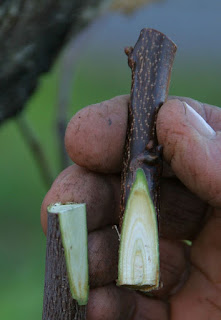Surrounded by woodlands, we have a high population of birds so our little orchard is a magnet for fruit eaters. And being the only active orchard nearby, every bird in the area has us in their sights. We used to lose 50% or more of our fruit to birds, so out of desperation I started experimenting with mechanical means of bird control a few years ago. The result is several home made bird scare machines that have been really successful, reducing our losses to below 5%.
Though these contraptions take major effort and time to set up and maintain every year, we would not be able to leave the fruit on the trees long enough to fully ripen without them. Since our passion is growing fruit with the best flavor, we do what we need to do to get that tree-ripened quality. And as a bonus, these devices get lots of smiles from passersby.
My first design below we christened "Bye-Bye Birdie". This one effectively prevents bird damage in the immediate area, about a 100 ft. diameter circle, and can be moved from place to place with the tractor as different trees ripen:
To cover larger areas I came up with the "Rope-a-dope" systems in the next videos. These are temporarily set up in a given area just before harvest, then taken down for storage. This first one covers about 1/4 acre with around 50 mature apricot trees.
This next one covers a similar sized block of peach trees.
And this one uses just a single rope strung over three cot trees that are away from the main group.
Another system in my arsenal is the "bird blower." This uses an electric leaf blower, run through PVC pipes, to power flapping plastic bags. It can be easily set up to defend a single tree or expanded to cover larger areas. For hard to protect crops I alternate between this system and the rope-a-dope to keep the birds wary.
So this time of year we have to put up with a bit of noise and fairly frequent repairs and tweaking of the bird scare machines. But without them we would not be able to provide customers with truly tree ripened fruit, or the hearty chuckles they get when witnessing the dancing ropes and milk jugs for the first time.
























